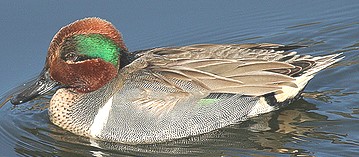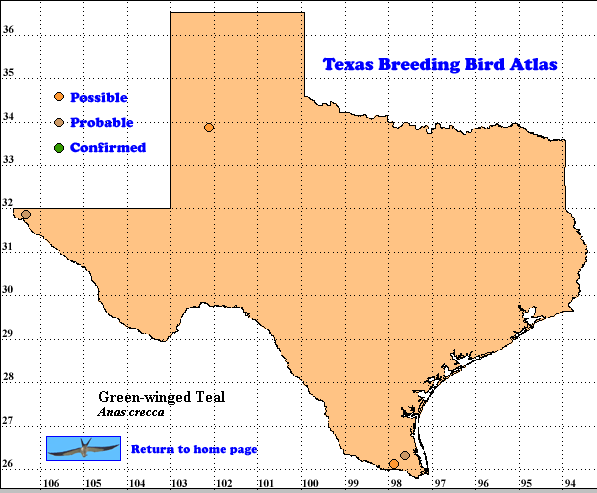Green-winged Teal, the smallest North American dabbling duck, is also one of the most attractive and a favorite with hunters. Probably because of its abundance, this duck is second only to Mallard (A. platyrhynchos) in numbers harvested annually in North America (Johnson 1995).
This opportunistic forager, like other dabblers, is often seen in shallow water with its head submerged and tail erect, searching for food such as: seeds of sedges, grasses, and other aquatic plants as well as aquatic insects and their larvae, mollusks and crustaceans (Johnson 1995).
DISTRIBUTION. During the 1987-1992 field work seasons of the TBBA project, atlasers found 2 probable and 3 possible breeding sites for Green-winged Teal. Of these one probable and 2 possibles were in the South Texas Brush Country near the Rio Grande, a probable was in El Paso County in the extreme western Trams-Pecos and a possible was on the High Plains (see the region map in Lockwood and Freeman [2004]). A map derived from North American Breeding Bird Survey (BBS) data shows an area on the High Plains with a relative abundance of <1 duck observed per 40 km (25 mi) route (Sauer et al. 2008). Atlasers in Oklahoma did not find breeding evidence for this species (Reinking 2004).
Most Green-wing Teal in North America breed in river deltas and forest wetlands of Alaska and northern Canada. Theses teal are much less common in the prairie potholes and wetlands used by other dabbling and diving ducks in North America. Green-wings winter along the Pacific Coast from southeast Alaska to Mexico as well as in most of the lower 48 contiguous United States, Mexico and some Caribbean islands. The Old Wield Teal, now considered the same species as Green-winged Teal, breeds and winters north of the Equator in Europe and Asia (Howell and Webb 1995, Johnson 1995, Am. Ornithol. Union 1998).
SEASONAL OCCURRENCE. Green- winged Teal are common to abundant migrants throughout Texas, arriving as early as late August with most arriving from late September to late November. Green-wings are uncommon to locally common in winter, especially on the upper coast. They begin departing in February with almost all gone by late April. These ducks are rare to occasional in Texas in summer with very few nesting records (Oberholser 1974, Johnson 1995, Lockwood and Freeman 2004). In Colorado with breeding evidence from 247 blocks, atlasers found breeding evidence from April 21 to August 12 (Boyle 1998).BREEDING HABITAT. In Colorado atlasers found fledged Green-winged Teal young in a variety of wetland and riparian habitats (Boyle 1998). In Arizona over 80% of breeding evidence came from wetland edges (Piest 2005). Although ducklings are raised in wetlands, most nests are placed on the ground in areas of dense cover, such as meadows, grasslands, brush thickets or woods, generally within 200 m (650 ft) of water. The female selects the site and first scrapes a bowl into the ground with her feet and lays the first egg in this scrape. Next she pulls nearby plant materials around and into the bowl. She uses these to form a neat nest. Down feathers are added to the nest once the final eggs are laid, prior to incubation. (Johnson 1995). A photo of a completed nest with eggs appears in Harrison (1979).
A clutch usually contains 8-9 (range 6-18) smooth, creamy white to pale olive buff eggs, indistinguishable from the eggs of other teal. The female incubates these eggs for 20-23 days before they hatch. After hatching the ducklings move to wetlands with their mother who broods and protects them. The young are capable of flight about 5 weeks after hatching, the shortest period for any North American duck (Harrison 1979, Johnson 1995, Piest 2005).
STATUS. There are few breeding records for Green-winged Teal in Texas with only one before 1974 (Oberholser 1974, Lockwood and Freeman 2004). The BBS does not attempt a trend estimate for this rare to occasional summer resident in Texas, but data from 325 routes across North America suggest a small annual population decline for the period 1980-2007 (Sauer et al. 2008). Although this duck will probably never be even a locally common breeding species in Texas, its winter status is very encouraging for its continuing presence on the list of Texas birds.
Text by Robert C. Tweit (2008)
Literature cited.
American Ornithologists’ Union. 1998. Checklist of North American birds, 7th ed. Am, Ornithol. Union, Washington, DC.
Boyle, S. 1998. Green-winged Teal (Anas crecca). In Colorado breeding bird atlas, pp. 86-87 (H. E. Kingery, ed.), Colorado Bird Atlas Partnership, Denver.
Harrison, H. H. 1979. A field guide to western birds’ nests. Houghton Mifflin, Boston, MA.
Howell, S. N. G. and S. Webb. 1995. A guide to the birds of Mexico and northern Central America. Oxford University Press, New York.
Johnson, K. 1995. Green-winged Teal (Anas crecca), The Birds of North America Online (A. Poole, Ed.). Ithaca: Cornell Lab of Ornithology; Retrieved from: http://bna.birds.cornell.edu/bna/species/193
Lockwood, M. W. and B. Freeman. 2004. The TOS handbook of Texas birds. Texas A&M University Press, College Station.
Oberholser, H. C. 1974. The bird life of Texas. University of Texas Press, Austin.
Piest, L. 2005. Green-winged Teal (Anas crecca). In Arizona breeding bird atlas. pp. 66-67 (T. E. Corman and C. Wise-Gervais, eds.), University of New Mexico Press, Albuquerque.
Reinking, D. L., ed. 2004. Oklahoma breeding bird atlas. University of Oklahoma Press, Norman.
Sauer, J. R., J. E. Hines, and J. Fallon. 2008. The North American breeding bird survey, results and analysis 1966-2007. Version 5.15.2008. USGS Patuxent Wildlife Research Center, Laurel MD < http://www.mbr-pwrc.usgs.gov/bbs>

